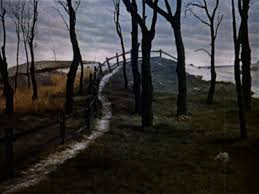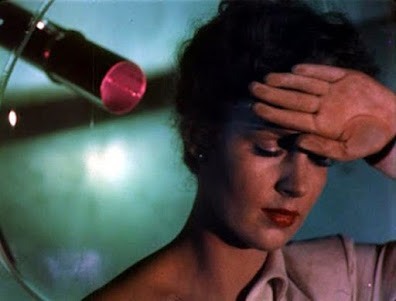For science fiction and horror movie aficionados of a certain age, there’s a split-rail fence, curved-wooded path, and sandpit that lurks somewhere in the recesses of the memory. It is the location of childhood nightmares and a weird reality or dream state from which you cannot awake. At least not fully.
That location doesn’t exist in The Twilight Zone, though it certainly could. Instead, it’s the setting for the alien terror in the 1953 movie, Invaders from Mars, from director William Cameron Menzies.
The film has been restored with loving attention in 4K UHD and is available now from Ignite Films. And, in short, Invaders from Mars has never looked better.
The film concerns a young boy, David MacLean (Jimmy Hunt), who awakens one night from slumber to a terrible disturbance. The boy looks out his bedroom window and sees a flying saucer at that distant hill, disappearing into that sandpit beyond the split-rail fence.
His father, George (Leif Erickson) goes out to investigate, but comes back altered; strange, cold, and callous. Soon, after Dad takes David’s mother (Hillary Brooke) up to the sandpit too, the same thing happens to her. Alone and afraid, David seeks help from the town police, but the adult world is not welcoming to him, or his wild story of strange aliens in the backyard.
Fortunately, a psychologist, Dr. Patricia Blake (Helena Carter), believes David’s tale, and with the help of a local astronomer, Dr. Kelston (Arthur Franz), contacts the U.S. Military for help. A wild night follows, as Martians and Americans clash in an underground, earthen labyrinth.
But when it ends, has David ended his nightmare, or begun it all over again?
“Don’t Go Spreading Stories…”
I have written before, and I hope persuasively, too, about the ways that Invaders from Mars and Phantasm (1979) share a theme and point of view. Both genre pictures concern the way that a young boy, on the verge of growing up, contends with the mysteries and nightmares of adult life.
In Phantasm, Michael must learn about the permanency of death, and so he conjures up his wild story about the Tall Man. In short, it is easier to battle a boogeyman than to face the grievous loss of parents, or a brother. He distracts himself with a “monster,” and a fight, and then he needn’t think about those who have died.
Invaders from Mars is not very different. But in this case, young David MacLean learns about what it means to grow up, and that lesson includes grappling with the idea that his parents are sexual beings, and that he, in adolescence, is starting to see the world in those terms.
The explicit terror in the film, for example, involves a Martian device, a drill not unlike a phallus, penetrating the back of the human neck. After this “act” of drilling, the victims are different; sharing secrets, uncommunicative to children, and in David’s eyes his parents no longer love him. At the very least, their attention is elsewhere.
Then, David turns his own attention to lovely Dr. Blake, and he becomes, in a real sense, her champion and hero. The film is a little boy’s fantasy of growing up, protecting, and being wanted by a beautiful woman. And since the movie begins and ends in that adolescent boy’s bedroom, one can parse the whole work of art as a kind of nocturnal dream about growing up. David corrals the military. David rescues Dr. Blake. David operates the Martian laser weapon. And, of course, he’s what, ten years old?
Like Michael in Phantasm, David creates a world for himself in which he doesn’t have to deal with the difficult questions of maturity. Instead, he’s a pint-sized action hero.
In their book, Twenty All-Time Great Science Fiction Films (Arlington House; 1982), authors Kenneth Von Gunden and Stuart H. Stock write meaningfully about the film’s central point of view, that of a child:
“IFM [Invaders from Mars] gives us a child’s perception of the parent-child relationship – an exaggerated view in which parents are kind and loving one moment and in the next for no apparent reason, cruel and hateful…IFM offers the child a convenient explanation for such changes. It’s not that the child has misbehaved, or that parents might have problems of their own, but that some outside force…has interfered to cause the change.” (Page 83)
What remains remarkable (and admirable) about the Menzies film, seventy years later, is the way that the visuals match and mirror the dream qualities of the plot. For example, the film’s sets ar expressionist in design, with young David journeying to a minimalist police station, and finding himself dwarfed by the furniture there. Absolutely everything is over-sized there, except him. A different shot, in a jail cell, reveals bars reflected on David’s face, and the inference is that we are living in a child’s world. One where only children can tell who is good and who is evil.
One early scene finds David consigned to the rear of the frame, as his altered father, and his mother, converse in the foreground. The old adage that children should be seen but not heard comes immediately to mind. David is an afterthought in the moment, and the director’s choice of framing tells us just how unimportant he is to his parents. Or maybe how unimportant he feels.
Across the last seven decades, there has been much debate about the nature of this low budget film. It relies on stock-footage. It re-uses the same sets. And Invaders from Mars’ story doesn’t strictly make sense as we understand it. And the ending? Well, the ending suggests the adventure is an endless loop, all about to happen again. It is a nightmare from which David cannot awake. The debate is about whether these touches are intentional, or a result of a low budget.
No one has had the last word on this point, but the exigencies of production, in this case, help Invaders from Mars maintain its creepy tenor. The fact that the scientist’s laboratory is the same set as the police station, only plays into the film’s weird, dream-like quality.
And the shots of the Martian drones (or “mutants”) running through their subterranean caves are repeated, sometimes it feels endlessly. But again, that idea of a loop, of something happening over and over, only reinforces the film’s unnerving finale, which explicitly suggests the invasion is starting all over again too. Indeed the film keeps remaking itself, before it even finishes. The audience sees one character (Dad) go into the sinkhole, then another (Mom), then another (a police officer), then another (an army man).
That’s why the film’s backyard locale is so unforgettable. It’s a treacherous sinkhole, but it shouldn’t be. David knows the truth, and no one else will believe him. The price for that disbelief is more life lost to the Martians.
Will audiences today, trained to see inconsistencies in plot, acting, and other facets of storytelling find the film worthwhile? It depends largely how open one is to letting Invaders from Mars’ “dream logic” wash over you. I suppose.
The film’s early scenes with David’s parents turned into alien servants, are terrific, creepy as hell and suggest all manners of interpersonal alienation, and dysfunctional family dynamics. As the film goes on, and it becomes rah-rah, Cold War propaganda for the U.S. Army, Invaders from Mars retains its strangeness, but nonetheless loses some of it most intriguing luster.
One thing is for certain, Menzies had a plan, and he executed it brilliantly. From the sickly green hue that suffuses much of the film, to the over-sized sets, to the central idea of a child’s perspective coloring the action, Invaders from Mars feels like a disturbing dream. These qualities keep the film alive in the psyche, and after seventy years, that’s no small feat.














Looking at the first (non-publicity) screenshot you posted, with the pathway and trees against a gray sky, I was struck how I was reminded of the title card from "Twin Peaks."
ReplyDelete